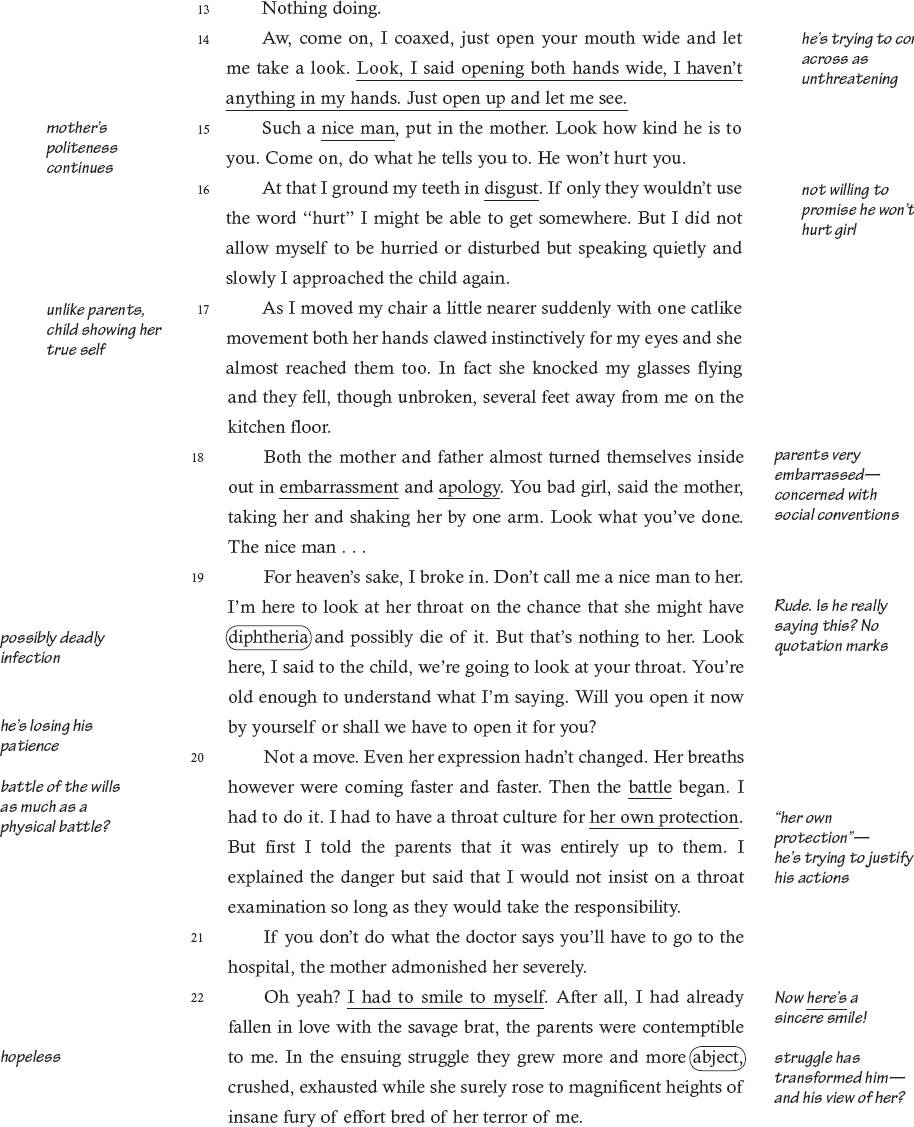A WRITER AT WORK
Isabella Wright’s Invention Work
In this section, you will see some of the work that Isabella Wright did in developing her essay analyzing the story “The Use of Force.” Using the Guide to Writing in this book, Wright chose the suggestions for interpreting character to guide her analysis of the story. As you will see,
- she annotated a portion of the story focusing on the doctor’s first attempts to examine the young patient’s throat;
- she wrote to explore her annotations on the passages;
- she listed ideas for formulating her tentative thesis statement.
You will be able to infer from her invention work how her ideas came to form the thesis she developed for her final essay.
Annotating
Wright annotated paragraphs 12–22 of “The Use of Force” as she reread them with the suggestions for analyzing character in mind. The annotated passages are reproduced here. Notice the diversity of her annotations:
- In the text itself, she underlined key words and circled words to be defined.
- In the margin, she defined words, made comments, and posed questions. She also expressed her tentative insights, reactions, and judgments.

As you can see, annotating this section of the story with the suggestions for analyzing character in mind led Wright to notice how much the doctor’s direct, and sometimes rude, manner is butting up against the parents’ politeness and embarrassment over their child’s behavior.
Examining Patterns in the Story
Following the instructions in the Ways In feature for generating ideas by moving from details to general ideas (pp. 478–79), Wright explored a pattern of contrast she saw between the doctor and the parents in the story. Here is what she wrote:
From the start of this scene, it feels like the whole experience between the doctor and the family is going to go from bad to worse. The doctor’s smile feels forced, almost as if he’s warning the little girl that she’s in for an unpleasant time. The parents’ attempts to smooth things over do nothing but irritate him, and he’s actually angered by being referred to as a “nice man.” It’s as if he has no time for the social conventions so important to the parents; these rules mean nothing to him, much less to the girl. In some ways, the doctor and the girl seem more alike than the doctor and the parents because he and the girl are showing their true selves. For that reason, maybe he even respects her more than he does the parents. The longer the two of them struggle, the more he seems to admire her. From the parents’ and the girl’s point of view, the experience is pretty clearly a bad one, but perhaps there’s something freeing about it from the doctor’s perspective.
As Wright wrote about the contrasts between the characters, she became increasingly confident that she not only had an interesting idea but had also one she could find support for in the story.
Listing Ideas
Wright tried out the activity on listing ideas from the Ways In feature on pp. 478–79. In doing so, she drew on both her annotations and on the exploratory writing she did about the doctor and the family (above):
The doctor comes across in a bad light: He’s rude and impatient and able to justify the use of force against the girl.
He has no time for the social conventions upheld by the parents.
He’s more annoyed than flattered by the mother’s compliments and attempts to smooth things over.
In this way, maybe he is more like the little girl than the parents.
They both seem to be showing their true selves.
In the end, it’s hard to condemn the doctor.
His break with social conventions feels freeing—maybe even transformative.
From these ideas about the doctor’s behavior and how his views about social conventions differ from those of the parents, Wright was able to devise the thesis statement she eventually used in her essay.